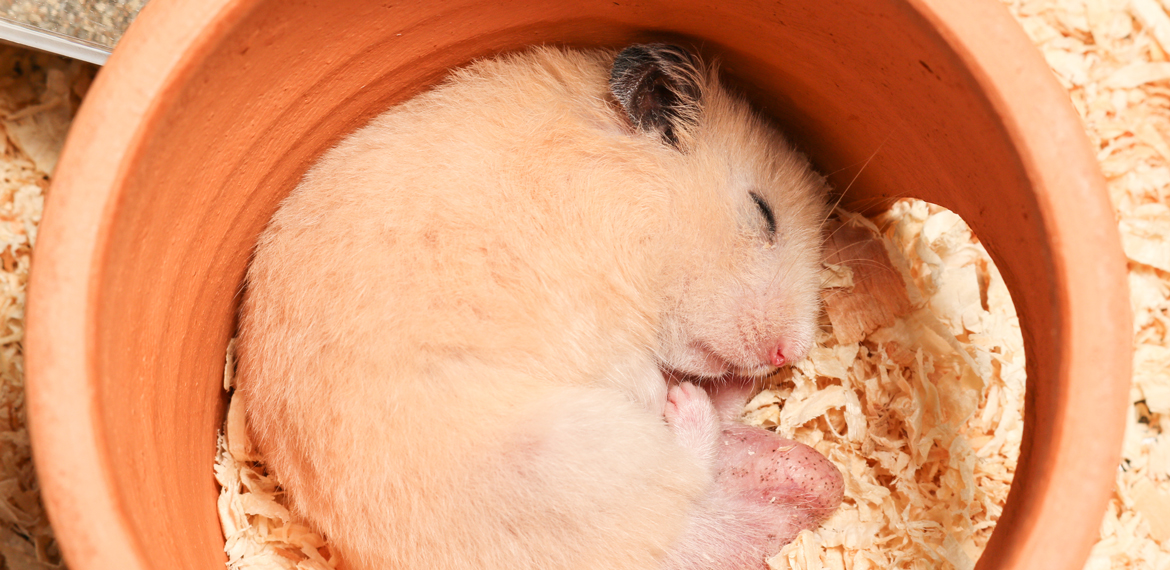Your hamster might go to sleep sometimes. Hamsters can get hurt like this, but is it good for them?
How often do they do this?
How do you wake up a hamster that has gone to sleep?
Since I have an adult Syrian hamster, I asked around and did research on this. So far, he’s been safe and hasn’t had to go into hibernation.
But I wanted to know what I could do if I ever had to save him. So, you now have the same information.
Do hamsters hibernate?
Torpor is a state that looks a lot like hibernation and is seen in animals like hamsters. Torpor is a long-term response to cold temperatures, like hibernation, but it only lasts for a shorter amount of time.
If your hamster sleeps for hours or even days at a time, especially when it’s cold, it’s probably in torpor. Some experts use the words “torpor” and “hibernation” interchangeably because the two processes are similar.
Surprisingly, not all species of hamsters behave the same way when they are hibernating. In the wild, European hamsters really do hibernate, sleeping for a long time during the cold winter months.
Dwarf hamsters are less likely to go into hibernation. Syrian hamsters are either “permissive” or “facultative” hibernators. This means that they don’t normally hibernate, but they can do so if the conditions are right.
Hamster females also hibernate for less time than hamster males. If you know how and when your hamster hibernates based on its breed and sex, you can tell when he or she is sleeping at home. To see if your hamster is in a state of torpor, you’ll need to look closely at its environment.
The most important thing about how hamsters hibernate is the temperature. Temperatures between 65 and 75 F are best for hamsters (18.3-23.8 C).
If the temperature drops below this level, your hamster might get too cold and fall asleep.
Make sure the temperature in your hamster’s cage is warm, but not too hot. Lots of clean, dry bedding should be in the cage at all times.
Your pet hamster should live in a well-ventilated room with its bedding. Watch out for cold draughts from windows or air conditioning systems, which could make the room too cold for your pet hamster.
What is hibernation?
Hamsters will go into hibernation, which is similar to sleeping when it gets too cold for them. This means that once they lie down to “sleep,” they will wake up when it’s much warmer and there will be food outside.
A hamster in hibernation has a very slow metabolism, so it doesn’t use much energy. He is hardly breathing and might even look like he has died.
Hibernation is something that many animals do to help them stay alive. When it starts to get cold, animals will start to gather food and build a warm, safe place to stay for the winter.
They curl up to go to sleep and wake up in the spring or when it’s warmer.
The animal’s shelter must be safe so that it won’t be found by predators or get flooded or covered. If this does happen, the animal won’t be able to fight back because it’s asleep.
How long do hamsters hibernate?
Most of the time, a hamster will only sleep for two to three days. So, if they don’t get enough water, food, warmth, or light, they may stay in a state called torpor and hibernate for a long time.
The longer they sleep, the worse they are for the animal. There are many ways to find out if your hamster is hibernating.
They may be in hibernation if they aren’t breathing as quickly as usual or if their bodies are limp when you pick them up.
You might feel that they are colder when you touch them. Hamsters go into hibernation, which is like sleeping when it gets too cold for them and their heart rate drops.
So, once they go to “sleep,” it will be much warmer when they wake up, and they’ll be able to eat outside.
A hamster in hibernation has a very slow metabolism and doesn’t use up much energy.
Different species use hibernation as a way to stay alive. When it gets cold, animals will gather food and build a warm, safe place to stay to get through the winter.
They curl up and go to sleep for the winter. In the spring or when the weather gets warmer, they wake up. The animal’s home must be safe from predators or from being covered or flooded.
If this happens, the animal won’t be able to fight back because it will be asleep.
When do hamsters hibernate?
Even the most careful hamster owners mess up sometimes when it comes to taking care of their pets.
If you forget to close a window on a windy day or don’t turn on the heat when a cold front is coming, it might be uncomfortable for you, but it could be fatal for your hamsters.
The Humane Society of the United States says that a Syrian hamster should be kept between 65 and 75 F. (18.3-23.8 C).
A Syrian hamster will go into hibernation if the temperature drops quickly or falls below 65 F. This is done to save energy (18.3 C). During hibernation, your hamster’s heart rate slows down and they save energy. This helps them deal with whether they aren’t used to it.
As a hamster owner, you don’t want your Syrian hamster to go into hibernation because he could die from the cold or from not drinking enough water.
Even though they come from cold climates, dwarf hamsters don’t hibernate. Even if you see hamsters sleeping with their eyes open, it doesn’t mean they are dead.
Open eyes don’t always mean that your hamster is still alive. They can sleep with their eyes open, with half of one eye closed, or with both eyes closed.
If your hamster’s body is as stiff as a board and you can’t move its limbs, it probably has Rigor Mortis, which means that your pet has died.
What to do if my hamster is hibernating?
Don’t worry if you find out your hamster is hibernating. If you slowly raise the temperature around them or move them if you have to, they should slowly start to wake up on their own.
Your pet might wake up during hibernation to eat, so leave food bowls, clean water bottles, and clean bedding out for them.
If you have any questions about your hamster’s health or well-being, you can talk to your vet or one of our pet care advisors at your local Pets at Home store.
Dangers of hibernation for hamsters
Hamsters in hibernation are in danger of a few things, but I’ll be talking mostly about pet hamsters here. Some of the dangers are:
- Mistaken for being dead – so you might end up burying a live hamster, who will stir awake after a few days or when it gets warmer, only to die of starvation later.
- Dehydration – hamsters do not drink a whole lot of water before hibernating, so when they wake up they will need a lot of water, but given in small, controlled amounts.
- Starvation – depending on how long the hibernation was, your hamster might be starved when he wakes up. Not just hungry, but actually starving.
- Death, if the hibernation is too long or the temperature drops much too low. Like losing your hamster outside in January for example.
- Coming out of it with a cold, or sick. Hamsters can’t deal with illnesses as well as humans, so they need immediate attention from your vet.
Is hibernation deadly for hamsters?
Hamsters can die when they go into hibernation, but you need to know why. How a wild hamster and a hamster kept as a pet goes into hibernation is very different.
The weather and temperature around a wild hamster will act as a kind of “warning” that winter is coming. So, he will have enough time to get ready. He will eat a lot and make a safe place to sleep.
He has months or even a whole year to get ready.
But a hamster that is kept in a cage doesn’t know this will happen, and almost always it is an accident.
For example, you went away for a few days and left the air conditioner on. It broke, so the house is now much too cold.
The hamster will then go into hibernation and only have the things you gave him before you left.
If you find your hamster within 24 hours of when he went into hibernation, he will be fine. If he stays longer than a few days, it gets more and more dangerous for him. He has nothing in his body that can protect him from the cold.
Hypothermia can be confused with hibernation
This is a big problem because these things can be mixed up. Hypothermia happens when your hamster is suddenly and for a long time in very cold weather.
For example, if you lose your hamster in the house and he finds a very cold corner to hide in. Or leaving your hamster outside when it’s freezing outside.
He can be shocked in this way by something as simple as putting his cage near a vent.
Hypothermia is especially dangerous because it happens without warning and your hamster won’t last long because his body doesn’t have enough resources to keep him alive.
Most pet hamsters that were said to be hibernating were actually in shock from being too cold. They were out in the cold for more than 24 hours and didn’t have time to get ready. Even if they were just a little bit cold.
But for this article, I’ll call this hibernation, since that’s what most people will call it.
How to tell your hamster is hibernating
A hamster that is hibernating will be very cold, limp, and not move at all. His paws and ears will feel cold, but the pouches in his cheeks should be warmer. He could be in his hiding place, or he could be anywhere in the cage.
Both his food and water won’t be touched. No signs of life at all.
A hamster in hibernation will be easy to spot, but it’s important to know if he’s sleeping or has died. You can figure this out by looking at a few signs.
Look to see if your hamster is breathing.
Breathing that is shallow and maybe even jerky. It could be as close as 2 minutes apart. But these should be. You need to keep a close eye on your hamster.
Use a mirror or look to see if his belly moves up and down.
Put a small mirror under his nose or mouth and look to see if anything is foggy. It should be there, even if it’s just a little bit. Just to be sure, leave it there for a few minutes.
Try to listen to the heartbeat of your hamster.
It will be hard to hear, and there won’t be many beats. You should find them, though. You can use a stethoscope to check this (if you have one at home, I don’t know).
Or, you can put him up to your ear and keep him there for a few minutes. Again, the beats will be very quiet, but they will be there.
Touch his ears or whiskers to see if he moves.
If you look very closely, you might be able to see that the hamster’s ears and whiskers move a little when you touch them.
Move the hamster’s feet.
His paws should be able to move, but there might be some resistance. If they are a little stiff, that’s fine; that’s what happens when his body gets very cold. But as long as you don’t have to work too hard to make it move, your hamster is fine.
How to wake up a hibernating hamster
When you wake up your hamster from hibernation, you shouldn’t do it all at once. This should be done slowly and gently to mimic the way a hamster naturally wakes up from hibernation.
Massage the hamster by picking him up.
This will help your hamster’s blood flow and warm him up slowly. You must do this for several hours. But you don’t have to get a massage all the time. It would be enough to just keep him in your pocket.
He will wake up on his own after a few hours of being warmed by your body heat.
Slowly make the area around the hamster warmer.
For example, you could turn up the heat or move his cage to a warmer room. You can also warm up the hamster by putting a warm (not hot) water bottle next to it.
Do not use direct heat to wake up the hamster.
Don’t try to wake the hamster up faster by putting it on a heater or somewhere else very hot. If you make it warmer around him, he will wake up on his own.
Also, don’t use a hair dryer to wake up the hamster. If the temperature changes quickly, your hamster will get into another kind of trouble that will require more care and treatment than hibernation.
Get in touch with your vet.
If you don’t know what to do, this might be the safest thing to do. Maybe you’ve tried everything, but your hamstring just won’t wake up. Get in touch with your vet and bring your hamster in for an exam.
How to care for a hamster that woke up from hibernation
When your hamster wakes up, there are a few things you need to do.
First, your hamster won’t have enough water in his body because he didn’t drink any. So give him some clean, fresh water. If you give him a bottle of water, he will drink from it on his own.
But if your hamster is moving very slowly, you can give him a few drops of water every few minutes with an eye dropper or syringe to make sure he stays hydrated.
For food, your hamster will need something that is easy for it to digest and gives it a lot of energy. For instance, a small piece of plain cooked chicken will do.
Then keep feeding him as you normally do. If the chicken is a little warm, that’s even better because it will help warm up your hammy.
CONCLUSION
I hope you were able to find what you needed here. I know it can be scary to walk into your room and see your hamster friend standing still with his eyes wide open.
But, you know, we can also sleep with our eyes open. We’re not really “seeing,” but our eyes are open a little bit.






